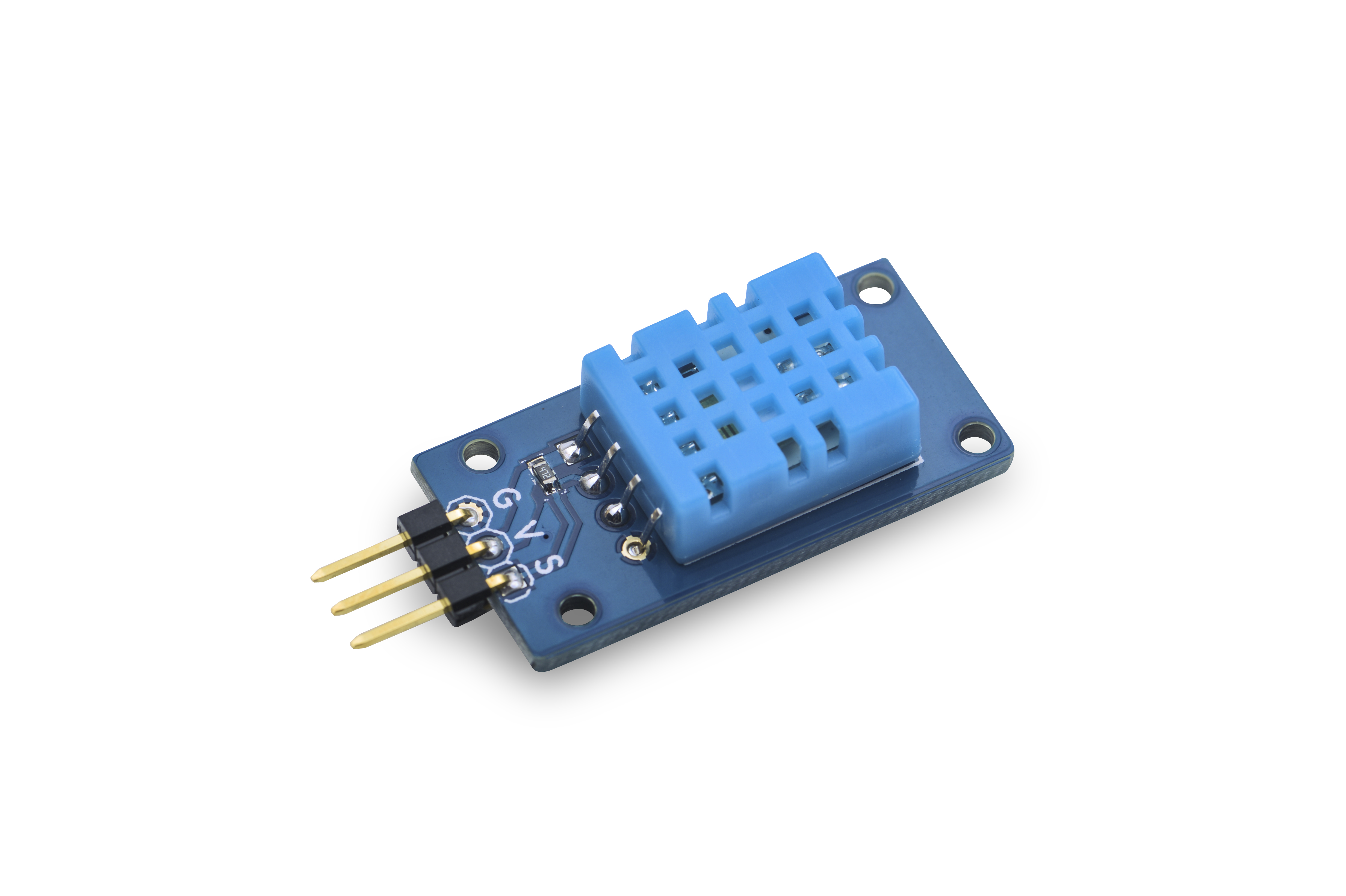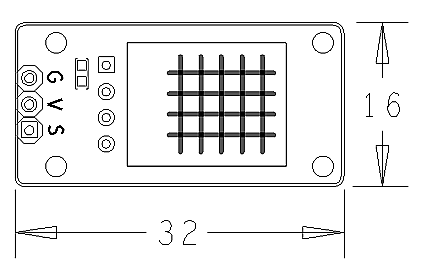Difference between revisions of "Matrix - Temperature and Humidity Sensor"
(→运行测试程序) |
(→Feb-23-2016) |
||
| (10 intermediate revisions by 2 users not shown) | |||
| Line 35: | Line 35: | ||
* After the user host (MCU) sends a signal DHT11 is converted from low-power mode to high-speed mode, until the host begins to signal the end. Then DHT11 sends a response signal to send 40bit data, and trigger a letter collection. If DHT11 doesn't receive a signal from the host it will not begin a letter collection. After the letter collection is done DHT11 will turn to low power mode. | * After the user host (MCU) sends a signal DHT11 is converted from low-power mode to high-speed mode, until the host begins to signal the end. Then DHT11 sends a response signal to send 40bit data, and trigger a letter collection. If DHT11 doesn't receive a signal from the host it will not begin a letter collection. After the letter collection is done DHT11 will turn to low power mode. | ||
| + | |||
| + | ==Applications== | ||
| + | ===Connect to NanoPi M1=== | ||
| + | Refer to the following connection diagram to connect the module to the NanoPi M1:<br> | ||
| + | [[File:Matrix-Temperature_and_Humidity_Sensor_nanopi_m1.jpg|frameless|600px|Matrix-Temperature_and_Humidity_Sensor_nanopi_m1]] | ||
| + | |||
| + | Connection Details: | ||
| + | {| class="wikitable" | ||
| + | |- | ||
| + | |Matrix-Temperature_and_Humidity_Sensor || NanoPi M1 | ||
| + | |- | ||
| + | |S || Pin7 | ||
| + | |- | ||
| + | |V || Pin4 | ||
| + | |- | ||
| + | |G || Pin6 | ||
| + | |} | ||
| + | |||
| + | ===Connect to NanoPi 2=== | ||
| + | Refer to the following connection diagram to connect the module to the NanoPi 2:<br> | ||
| + | [[File:Matrix-Temperature_and_Humidity_Sensor_nanopi_2.jpg|frameless|600px|Matrix-Temperature_and_Humidity_Sensor_nanopi_2]] | ||
| + | |||
| + | Connection Details: | ||
| + | {| class="wikitable" | ||
| + | |- | ||
| + | |Matrix-Temperature_and_Humidity_Sensor || NanoPi 2 | ||
| + | |- | ||
| + | |S || Pin7 | ||
| + | |- | ||
| + | |V || Pin4 | ||
| + | |- | ||
| + | |G || Pin6 | ||
| + | |} | ||
| + | |||
| + | ===Connect to NanoPi M2 / NanoPi 2 Fire=== | ||
| + | Refer to the following connection diagram to connect the module to the NanoPi M2/ NanoPi 2 Fire:<br> | ||
| + | [[File:Matrix-Temperature_and_Humidity_Sensor_nanopi_m2.jpg|frameless|600px|Matrix-Temperature_and_Humidity_Sensor_nanopi_m2]] | ||
| + | |||
| + | Connection Details: | ||
| + | {| class="wikitable" | ||
| + | |- | ||
| + | |Matrix-Temperature_and_Humidity_Sensor || NanoPi M2 | ||
| + | |- | ||
| + | |S || Pin7 | ||
| + | |- | ||
| + | |V || Pin4 | ||
| + | |- | ||
| + | |G || Pin6 | ||
| + | |} | ||
| + | |||
| + | ===Connect to NanoPC-T2=== | ||
| + | Refer to the following connection diagram to connect the module to the NanoPC-T2:<br> | ||
| + | [[File:Matrix-Temperature_and_Humidity_Sensor_NanoPC-T2.jpg|frameless|600px|Matrix-Temperature_and_Humidity_Sensor_NanoPC-T2]] | ||
| + | |||
| + | Connection Details: | ||
| + | {| class="wikitable" | ||
| + | |- | ||
| + | |Matrix-Temperature_and_Humidity_Sensor || NanoPC-T2 | ||
| + | |- | ||
| + | |S || Pin15 | ||
| + | |- | ||
| + | |V || Pin29 | ||
| + | |- | ||
| + | |G || Pin30 | ||
| + | |} | ||
| + | |||
| + | ==Compile & Run Test Program== | ||
| + | Boot your ARM board with Debian and copy the matrix code: | ||
| + | <syntaxhighlight lang="bash"> | ||
| + | $ apt-get update && apt-get install git | ||
| + | $ git clone https://github.com/friendlyarm/matrix.git | ||
| + | </syntaxhighlight> | ||
| + | If your cloning is done successfully a "matrix" directory will be generated. | ||
| + | |||
| + | Compile and install Matrix: | ||
| + | <syntaxhighlight lang="bash"> | ||
| + | $ cd matrix | ||
| + | $ make && make install | ||
| + | </syntaxhighlight> | ||
| + | |||
| + | Run test program: | ||
| + | <syntaxhighlight lang="bash"> | ||
| + | $ matrix-temp_humidity | ||
| + | </syntaxhighlight> | ||
| + | Note: this module is not plug and play therefore before running the module please make sure it is connected to an ARM board.<br> | ||
| + | Here is what you should observe:<br> | ||
| + | <syntaxhighlight lang="bash"> | ||
| + | The humidity is 35000 | ||
| + | The temperature is 26000 | ||
| + | </syntaxhighlight> | ||
| + | The module successfully read the environment's humidity and temperature values. | ||
| + | |||
| + | ==Code Sample== | ||
| + | This Matrix code sample can work with all the ARM boards mentioned in this module's wiki. The name of this code sample is "matrix-temperature_and_humidity_sensor". Here is its source code: | ||
| + | <syntaxhighlight lang="c"> | ||
| + | int main(int argc, char ** argv) | ||
| + | { | ||
| + | int ret = -1; | ||
| + | int dhtTemp=0, dhtHdty=0, board; | ||
| + | char modStr[BUF_SIZE]; | ||
| + | int pin = GPIO_PIN(7); | ||
| + | |||
| + | if ((board = boardInit()) < 0) { | ||
| + | printf("Fail to init board\n"); | ||
| + | return -1; | ||
| + | } | ||
| + | if (board == BOARD_NANOPI_T2) | ||
| + | pin = GPIO_PIN(15); | ||
| + | |||
| + | sprintf(modStr, "modprobe %s gpio=%d", DRIVER_MODULE, pintoGPIO(pin)); | ||
| + | system(modStr); | ||
| + | if ((ret = dht11Read(DHT_HUMIDITY, &dhtHdty)) != -1) { | ||
| + | printf("The humidity is %d\n", dhtHdty); | ||
| + | } else { | ||
| + | printf("Faided to get humidity\n"); | ||
| + | } | ||
| + | if ((ret = dht11Read(DHT_TEMP, &dhtTemp)) != -1) { | ||
| + | printf("The temperature is %d\n", dhtTemp); | ||
| + | } else { | ||
| + | printf("Faided to get temperature\n"); | ||
| + | } | ||
| + | system("rmmod "DRIVER_MODULE); | ||
| + | return ret; | ||
| + | } | ||
| + | </syntaxhighlight> | ||
| + | For more details about this APIs called in this code sample refer to [[Matrix API reference manual]] <br> | ||
| + | |||
| + | <!--- | ||
==Download Matrix Source Code== | ==Download Matrix Source Code== | ||
| − | All the matrix modules' code samples are open source. They are maintained on GitHub - | + | All the matrix modules' code samples are open source. They are maintained on GitHub - https://github.com/friendlyarm/matrix.git <br> |
Each branch in this hub contains the matrix modules' code samples for a board that the matrix modules can work with.<br> | Each branch in this hub contains the matrix modules' code samples for a board that the matrix modules can work with.<br> | ||
* The nanopi branch contains the matrix modules' code samples for the NanoPi | * The nanopi branch contains the matrix modules' code samples for the NanoPi | ||
| + | * The nanopi 2 branch contains the matrix modules' code samples for the NanoPi 2 | ||
* The tiny4412 branch contains the matrix modules' code samples for the Tiny4412 | * The tiny4412 branch contains the matrix modules' code samples for the Tiny4412 | ||
* The raspberrypi branch contains the matrix modules' code samples for the RaspberryPi | * The raspberrypi branch contains the matrix modules' code samples for the RaspberryPi | ||
| Line 50: | Line 179: | ||
Clone the matrix code from GitHub | Clone the matrix code from GitHub | ||
<syntaxhighlight lang="bash"> | <syntaxhighlight lang="bash"> | ||
| − | $ git clone | + | $ git clone https://github.com/friendlyarm/matrix.git |
</syntaxhighlight> | </syntaxhighlight> | ||
If this is successful a "matrix" directory will be generated, which will contain all the matrix modules' code samples. | If this is successful a "matrix" directory will be generated, which will contain all the matrix modules' code samples. | ||
| + | |||
| + | ==Connect to NanoPi 2== | ||
| + | ===Hardware Connection=== | ||
| + | Please refer to the following connection diagram to connect the Matrix-Temperature_and_Humidity_Sensor to the NanoPi 2:<br> | ||
| + | [[File:Matrix-Temperature_and_Humidity_Sensor_nanopi_2.jpg|frameless|600px|Matrix-Temperature_and_Humidity_Sensor_nanopi_2]] | ||
| + | |||
| + | Connection Details: | ||
| + | {| class="wikitable" | ||
| + | |- | ||
| + | |Matrix-Temperature_and_Humidity_Sensor || NanoPi 2 | ||
| + | |- | ||
| + | |S || Pin7 | ||
| + | |- | ||
| + | |V || Pin4 | ||
| + | |- | ||
| + | |G || Pin6 | ||
| + | |} | ||
| + | |||
| + | ===Compile Test Program=== | ||
| + | Please login the matrix hub and enter the nanopi2 branch | ||
| + | <syntaxhighlight lang="bash"> | ||
| + | $ cd matrix | ||
| + | $ git checkout nanopi2 | ||
| + | </syntaxhighlight> | ||
| + | |||
| + | Compile the matrix code | ||
| + | <syntaxhighlight lang="bash"> | ||
| + | $ make CROSS_COMPILE=arm-linux- clean | ||
| + | $ make CROSS_COMPILE=arm-linux- | ||
| + | $ make CROSS_COMPILE=arm-linux- install | ||
| + | </syntaxhighlight> | ||
| + | Note: please make sure to install the cross compiler "arm-linux-gcc-4.9.3" on your PC, which is used to compile files for the NanoPi 2.<br> | ||
| + | Generated library files are under the "install/lib" directory. The test program is under the "install/usr/bin" directory.<br> | ||
| + | The modules are under the "modules" directory. The driver's source code is in github: https://github.com/friendlyarm/linux-3.4.y.git <br> | ||
| + | |||
| + | ===Run Test Program=== | ||
| + | Please insert a TF card which is flashed with Debian to a Linux host and mount its boot and rootfs sections.<br> | ||
| + | We assume the rootfs is mounted to /media/rootfs then please run the following commands to copy the module, library and test program to the card.<br> | ||
| + | <syntaxhighlight lang="bash"> | ||
| + | $ cp modules /media/rootfs/ -r | ||
| + | $ cp install/lib/* /media/rootfs/lib/ -d | ||
| + | $ cp install/usr/bin/* /media/rootfs/usr/bin/ | ||
| + | </syntaxhighlight> | ||
| + | |||
| + | Insert this TF card to your NanoPi 2, power on and run the following commands to load the driver.<br> | ||
| + | <syntaxhighlight lang="bash"> | ||
| + | $ cd /modules | ||
| + | $ insmod dht11.ko | ||
| + | </syntaxhighlight> | ||
| + | |||
| + | Start the matrix-temp_humidity program.<br> | ||
| + | <syntaxhighlight lang="bash"> | ||
| + | $ matrix-temp_humidity | ||
| + | </syntaxhighlight> | ||
| + | |||
| + | Here is what you expect to observe:<br> | ||
| + | [[File:matrix-temp_humidity_result.png|frameless|600px|matrix-temp_humidity_result]] <br> | ||
| + | |||
| + | ===Code Sample=== | ||
| + | <syntaxhighlight lang="c"> | ||
| + | int main(int argc, char ** argv) | ||
| + | { | ||
| + | int ret = -1; | ||
| + | int dhtTemp = 0; | ||
| + | int dhtHdty = 0; | ||
| + | |||
| + | if ((ret = dht11Read(DHT_HUMIDITY, &dhtHdty)) != -1) { | ||
| + | printf("Get humidity : %d\n", dhtHdty); | ||
| + | } else { | ||
| + | printf("Faided to get humidity\n"); | ||
| + | } | ||
| + | |||
| + | if ((ret = dht11Read(DHT_TEMP, &dhtTemp)) != -1) { | ||
| + | printf("Get temperature : %d\n", dhtTemp); | ||
| + | } else { | ||
| + | printf("Faided to get temperature\n"); | ||
| + | } | ||
| + | |||
| + | return ret; | ||
| + | } | ||
| + | </syntaxhighlight> | ||
==Connect to NanoPi== | ==Connect to NanoPi== | ||
| Line 112: | Line 322: | ||
</syntaxhighlight> | </syntaxhighlight> | ||
| − | === | + | ===Code Sample=== |
<syntaxhighlight lang="c"> | <syntaxhighlight lang="c"> | ||
int main(int argc, char ** argv) | int main(int argc, char ** argv) | ||
| Line 149: | Line 359: | ||
</syntaxhighlight> | </syntaxhighlight> | ||
| − | == | + | ==Connect to Tiny4412== |
| − | === | + | ===Preparations=== |
| − | + | Please refer to the Tiny4412's user's manual to install a UbuntuCore on the Tiny4412 and install an appropriate cross compiler on a PC.<br> | |
| − | + | Note: only the Tiny4412SDK-1506 carrier board can work with this module. | |
| − | === | + | ===Hardware Connection=== |
| − | + | Please refer to the following diagram to connect the Matrix-Temperature_and_Humidity_Sensor to the Tiny4412 <br> | |
[[File:matrix-temperature_and_humidity_sensor_tiny4412.jpg|frameless|600px|matrix-temperature_and_humidity_sensor_tiny4412]] | [[File:matrix-temperature_and_humidity_sensor_tiny4412.jpg|frameless|600px|matrix-temperature_and_humidity_sensor_tiny4412]] | ||
| − | + | Connection Details: | |
{| class="wikitable" | {| class="wikitable" | ||
|- | |- | ||
| Line 170: | Line 380: | ||
|} | |} | ||
| − | === | + | ===Compile Test Program=== |
| − | + | Please login the Matrix hub and enter the matrix-tiny4412 branch | |
<syntaxhighlight lang="bash"> | <syntaxhighlight lang="bash"> | ||
$ cd matrix | $ cd matrix | ||
| Line 177: | Line 387: | ||
</syntaxhighlight> | </syntaxhighlight> | ||
| − | + | Compile the matrix code | |
<syntaxhighlight lang="bash"> | <syntaxhighlight lang="bash"> | ||
$ make CROSS_COMPILE=arm-linux-gnueabihf- clean | $ make CROSS_COMPILE=arm-linux-gnueabihf- clean | ||
| Line 183: | Line 393: | ||
$ make CROSS_COMPILE=arm-linux-gnueabihf- install | $ make CROSS_COMPILE=arm-linux-gnueabihf- install | ||
</syntaxhighlight> | </syntaxhighlight> | ||
| − | + | Note: please make sure to install the cross compiler "arm-linux-gnueabihf-gcc-4.7.3" on your PC, which is used to compile files for the Tiny4412-UbuntuCore.<br> | |
| − | + | Generated library files are under the "install/lib" directory. Applications are under the "install/usr/bin" directory. The test program for the "Matrix-Temperature_and_Humidity_Sensor" module is "matrix-temp_humidity". | |
| − | === | + | ===Run Test Program=== |
| − | + | Please copy the library files and test program to the Tiny4412 | |
<syntaxhighlight lang="bash"> | <syntaxhighlight lang="bash"> | ||
$ cp install/usr/usr/bin/* tiny4412_rootfs/usr/usr/bin/ | $ cp install/usr/usr/bin/* tiny4412_rootfs/usr/usr/bin/ | ||
| Line 193: | Line 403: | ||
</syntaxhighlight> | </syntaxhighlight> | ||
| − | + | Power on the Tiny4412 and run the following command in UbuntuCore's terminal <br> | |
| − | + | Note: this module is not plug and play therefore before running the module please make sure it is connected to a Tiny4412. | |
<syntaxhighlight lang="bash"> | <syntaxhighlight lang="bash"> | ||
$ matrix-temp_humidity | $ matrix-temp_humidity | ||
</syntaxhighlight> | </syntaxhighlight> | ||
| − | === | + | ===Code Sample=== |
<syntaxhighlight lang="c"> | <syntaxhighlight lang="c"> | ||
int main(int argc, char ** argv) | int main(int argc, char ** argv) | ||
| Line 236: | Line 446: | ||
</syntaxhighlight> | </syntaxhighlight> | ||
| − | == | + | ==Connect to RaspberryPi== |
| − | == | + | ==Connect to Arduino== |
| + | ---> | ||
| − | == | + | ==Resources== |
[http://akizukidenshi.com/download/ds/aosong/DHT11.pdf DHT11.pdf] | [http://akizukidenshi.com/download/ds/aosong/DHT11.pdf DHT11.pdf] | ||
| + | |||
| + | ==Update Log== | ||
| + | ===Feb-23-2016=== | ||
| + | * Added the description for "NanoPi 2 branch" in Section 4 | ||
| + | * Added Section 5: Connect to NanoPi 2 | ||
| + | ===June-24-2016=== | ||
| + | * Re-organized and simplified wiki | ||
Latest revision as of 15:50, 24 June 2016
Contents
1 Introduction
- The Matrix-Temperature_and_Humidity_Sensor module is used to detect temperature and humidity.
- It utilizes the DHT11 temperature and humidity sensor. Its humidity range is 20% - 80% and the accuracy is 5%. Its temperature range is 0℃ - 50℃ and the accuracy is ±2℃.
2 Features
- Humidity range: 20 - 80%RH, Temperature range 0 ~ 50℃
- Accuracy of humidity: +-5%RH, accuracy of temperature: +-2℃
- One wire communication
- 2.54 mm spacing pin
- PCB dimension (mm): 16 x 32
Pin Description:
| Pin | Description |
| S | GPIO |
| V | Supply Voltage 5V |
| G | Ground |
3 Basic Device Operation
The DHT11 module uses a simplified single-bus serial communication. DATA controls communication and synchronization between the microprocessor and DHT11. A data transfer takes 4ms. The data format contains an integer part and a decimal part. The basic operation is as follows:
- a transmission of 40 data, the high first-out
- data format: 8bit humidity integer data + 8bit the Humidity decimal data
- 8bit temperature integer data + 8bit fractional temperature data
- 8 bit parity bit
- If a transmission is successful the “8bit humidity integer data + 8bit humidity decimal data +8 bit temperature integer data + 8bit temperature fractional data” 8bit checksum is equal to the results of the last eight.
- After the user host (MCU) sends a signal DHT11 is converted from low-power mode to high-speed mode, until the host begins to signal the end. Then DHT11 sends a response signal to send 40bit data, and trigger a letter collection. If DHT11 doesn't receive a signal from the host it will not begin a letter collection. After the letter collection is done DHT11 will turn to low power mode.
4 Applications
4.1 Connect to NanoPi M1
Refer to the following connection diagram to connect the module to the NanoPi M1:
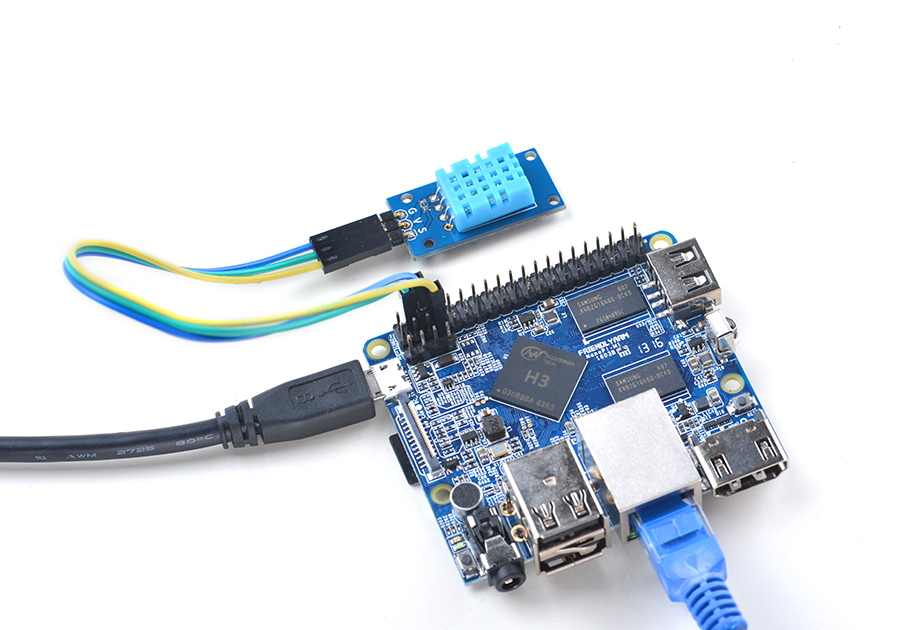
Connection Details:
| Matrix-Temperature_and_Humidity_Sensor | NanoPi M1 |
| S | Pin7 |
| V | Pin4 |
| G | Pin6 |
4.2 Connect to NanoPi 2
Refer to the following connection diagram to connect the module to the NanoPi 2:
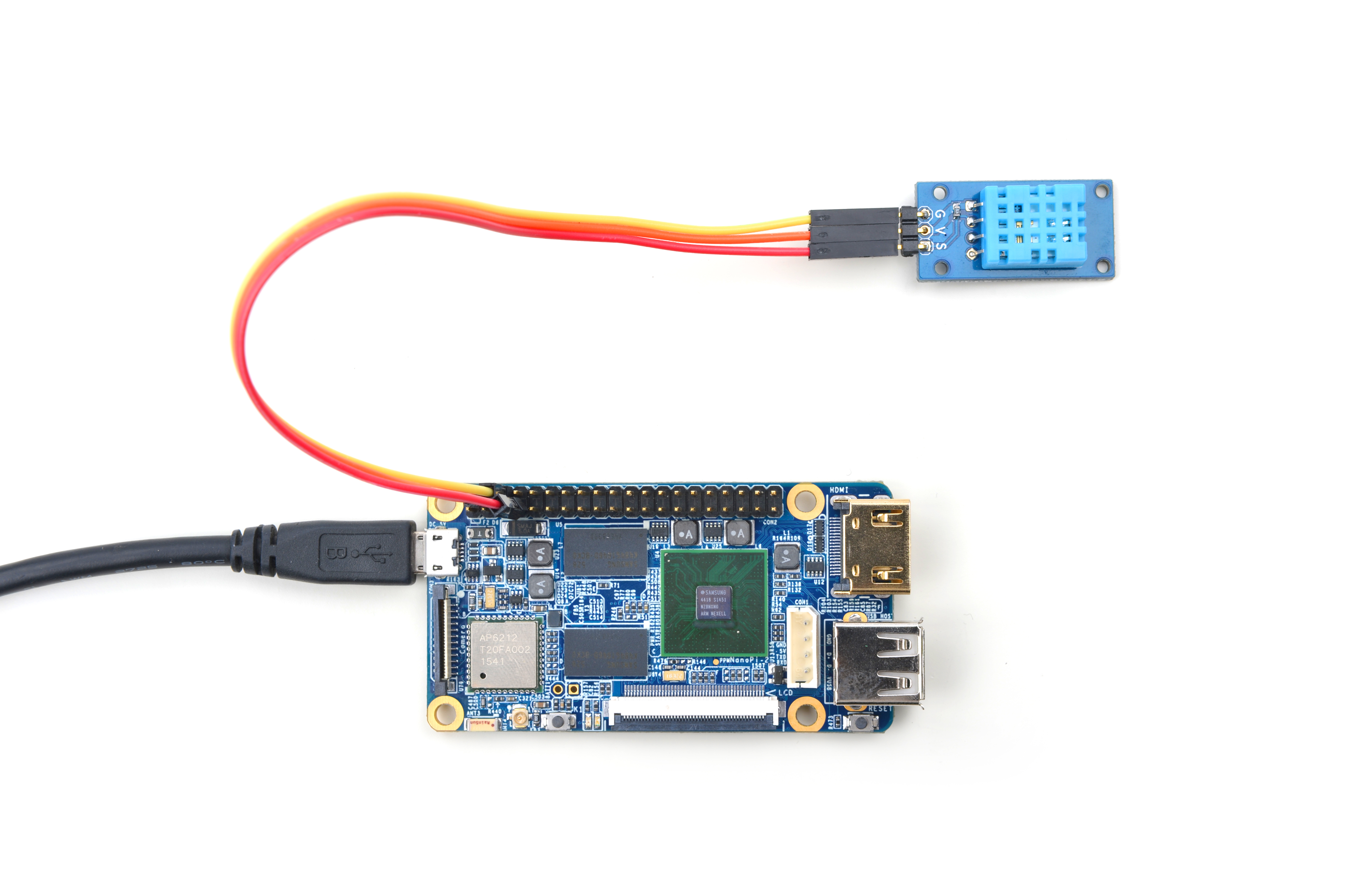
Connection Details:
| Matrix-Temperature_and_Humidity_Sensor | NanoPi 2 |
| S | Pin7 |
| V | Pin4 |
| G | Pin6 |
4.3 Connect to NanoPi M2 / NanoPi 2 Fire
Refer to the following connection diagram to connect the module to the NanoPi M2/ NanoPi 2 Fire:
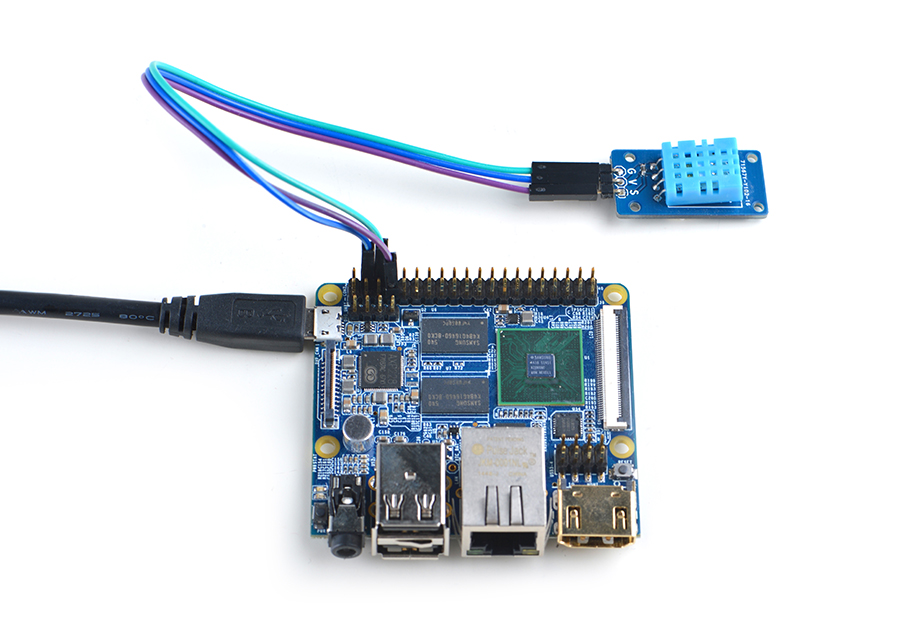
Connection Details:
| Matrix-Temperature_and_Humidity_Sensor | NanoPi M2 |
| S | Pin7 |
| V | Pin4 |
| G | Pin6 |
4.4 Connect to NanoPC-T2
Refer to the following connection diagram to connect the module to the NanoPC-T2:
Matrix-Temperature_and_Humidity_Sensor_NanoPC-T2
Connection Details:
| Matrix-Temperature_and_Humidity_Sensor | NanoPC-T2 |
| S | Pin15 |
| V | Pin29 |
| G | Pin30 |
5 Compile & Run Test Program
Boot your ARM board with Debian and copy the matrix code:
$ apt-get update && apt-get install git $ git clone https://github.com/friendlyarm/matrix.git
If your cloning is done successfully a "matrix" directory will be generated.
Compile and install Matrix:
$ cd matrix $ make && make install
Run test program:
$ matrix-temp_humidityNote: this module is not plug and play therefore before running the module please make sure it is connected to an ARM board.
Here is what you should observe:
The humidity is 35000 The temperature is 26000
The module successfully read the environment's humidity and temperature values.
6 Code Sample
This Matrix code sample can work with all the ARM boards mentioned in this module's wiki. The name of this code sample is "matrix-temperature_and_humidity_sensor". Here is its source code:
int main(int argc, char ** argv) { int ret = -1; int dhtTemp=0, dhtHdty=0, board; char modStr[BUF_SIZE]; int pin = GPIO_PIN(7); if ((board = boardInit()) < 0) { printf("Fail to init board\n"); return -1; } if (board == BOARD_NANOPI_T2) pin = GPIO_PIN(15); sprintf(modStr, "modprobe %s gpio=%d", DRIVER_MODULE, pintoGPIO(pin)); system(modStr); if ((ret = dht11Read(DHT_HUMIDITY, &dhtHdty)) != -1) { printf("The humidity is %d\n", dhtHdty); } else { printf("Faided to get humidity\n"); } if ((ret = dht11Read(DHT_TEMP, &dhtTemp)) != -1) { printf("The temperature is %d\n", dhtTemp); } else { printf("Faided to get temperature\n"); } system("rmmod "DRIVER_MODULE); return ret; }
For more details about this APIs called in this code sample refer to Matrix API reference manual
7 Resources
8 Update Log
8.1 Feb-23-2016
- Added the description for "NanoPi 2 branch" in Section 4
- Added Section 5: Connect to NanoPi 2
8.2 June-24-2016
- Re-organized and simplified wiki
